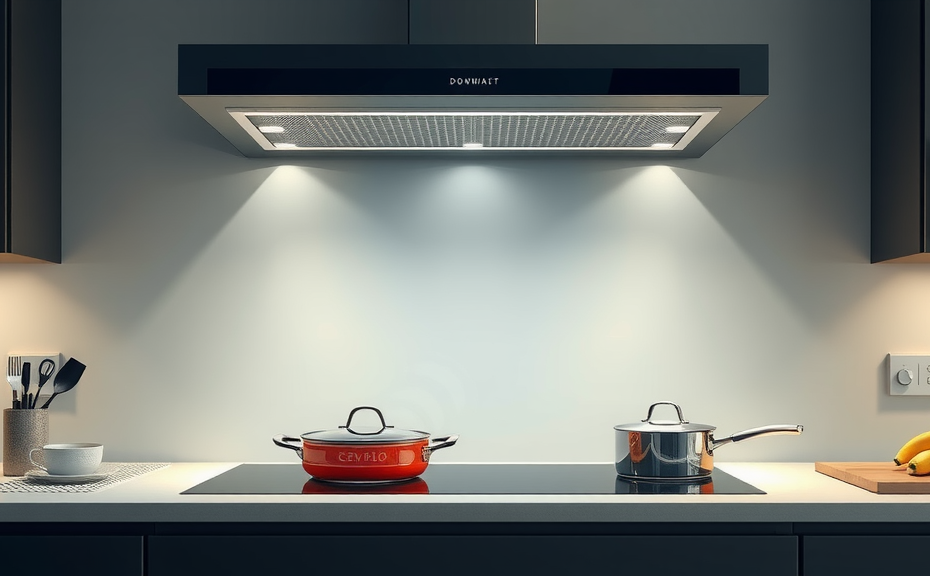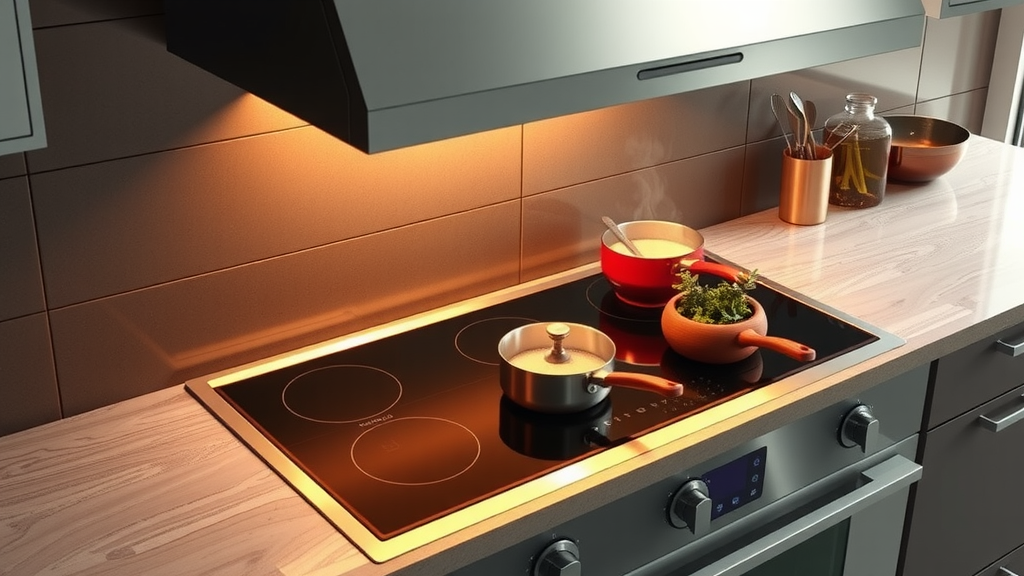A unique kitchen feature combines aesthetics with practical solutions, enhancing cooking experiences. These versatile units integrate ventilation directly into the cooking surface, allowing for improved airflow while preparing meals.
Unlike conventional systems requiring large overhead hoods, downdraft designs offer a streamlined appearance that appeals to many modern homeowners.
Surprisingly, they can significantly minimize smoke and odors during cooking, adding to their appeal for culinary enthusiasts.
Such cooktops can elevate kitchen design by saving valuable space and offering various layout options. The performance of these models in heat distribution is noteworthy, contributing to greater efficiency in cooking times and overall food quality.
Are Downdraft Cooktops Efficient
Efficient kitchen ventilation plays a significant role in maintaining a comfortable cooking environment, and downdraft cooktops are designed to address this need effectively. These systems integrate smoke removal directly from the cooking surface, which can facilitate better control over airborne particles and odors.
Typical energy consumption for such units ranges from 300 to 600 watts during operation, a figure comparable to other standard cooking appliances.
This energy efficiency can lead to lower utility bills without sacrificing performance.
The design of downdraft cooktops often enhances heat distribution, allowing for faster cooking times while minimizing energy usage. This combination of features makes them a compelling choice for those seeking to optimize their cooking spaces.
Understanding Downdraft Ventilation Systems
The mechanics of modern ventilation appliances have evolved significantly, offering innovative solutions for maintaining air quality in culinary spaces. Downdraft systems use a fan mechanism to draw cooking air downward, creating an alternative to traditional range hoods.
This integration within the cooktop or countertop promotes a more versatile kitchen design, effectively reducing visual clutter while capturing smoke, steam, and odors during cooking.
Primary components of these systems include the fan, filters, and ducting.
The blower’s design influences airflow efficiency, impacting the appliance’s effectiveness in minimizing airborne contaminants.
For optimal performance and safety during cooking, maintaining clear and unobstructed airflow is paramount.
When planning an installation, careful consideration of placement within the kitchen layout is required. Downdraft systems are compatible with various cooktop types, including gas and electric models, allowing versatility in design. Properly maintaining your appliance ensures safety whether you use induction, gas, or electric options.
| Component | Function |
|---|---|
| Fan | Draws cooking air downward |
| Filters | Captures smoke, steam, and odors |
| Ducting | Facilitates airflow efficiency |
| Cooktop Compatibility | Works with gas and electric models |
Comparing Induction And Gas Cooktops
Choosing a cooking surface involves considering various factors such as efficiency, performance, and safety features. Induction models are often regarded as more user-friendly due to their ability to heat cookware almost instantaneously, achieving desired temperatures in typically half the time required by traditional options.
These cooktops harness integrated technology to allow for precise heat control, which enhances cooking consistency.
Interestingly, while induction employs electromagnetic energy to generate heat, gas cooktops rely on combustion, leading to notable differences in energy conversion.
Remarkably, induction cooktops convert approximately 85-90% of energy into usable heat, contrasting with the 40-55% efficiency rates seen in gas models. This disparity can significantly influence long-term operational costs for homeowners.
Regarding safety, induction cooktops cool down rapidly once the cookware is removed, which greatly reduces the risk of burn injuries. In comparison, the integrated, modern design enhances user-friendliness while effectively managing aesthetics, noise level, and heat control.
Evaluating Airflow Performance In Kitchens
Effective airflow management plays a pivotal role in enhancing culinary experiences and overall comfort within cooking spaces. Proper ventilation systems are designed to eliminate smoke, steam, and unwanted odors, thereby promoting a more enjoyable cooking environment.
Common types of ventilation include wall-mounted range hoods and integrated downdraft systems.
These innovative downdraft options are seamlessly installed into countertops, preserving kitchen aesthetics while optimizing functionality.
A notable characteristic of downdraft systems is their enhanced emission capture, particularly when utilized with induction cooktops, which can significantly improve energy consumption by using heat more efficiently. Airflow is quantified in cubic feet per minute (CFM), with residential kitchens requiring different capacities based on their size.
Often overlooked, the quality of ductwork plays an important role in both energy consumption and overall efficiency, making it a factor worth assessing for homeowners seeking to improve their culinary systems.
| Ventilation Type | Benefits |
|---|---|
| Wall-mounted range hoods | Eliminate smoke and odors |
| Integrated downdraft systems | Preserve kitchen aesthetics and optimize functionality |
| Induction cooktops with downdraft | Enhanced emission capture and improved energy efficiency |
| Airflow measurement (CFM) | Determines required ventilation capacity based on kitchen size |
Benefits Of Integrated Downdraft Features
Incorporating advanced ventilation solutions can significantly improve the overall functionality of a kitchen. Integrated downdraft features play a substantial role in enhancing cooking experiences.
Enhanced Cooking Efficiency is a primary advantage of these systems.
They actively eliminate smoke and heat at the source, which leads to improved air quality, particularly benefiting spaces with open layouts where odors can easily circulate.
This capability allows for a more pleasant cooking environment while preparing meals.
Space Optimization presents another noteworthy benefit.
Traditional range hoods can occupy valuable overhead space, impacting the kitchen’s modular design. Conversely, integrated downdraft systems remain concealed within the cooktop, leading to a sleek layout that optimizes available space.
This innovative approach not only promotes a cleaner aesthetic but also makes the area feel more expansive. The versatility of such systems ensures they can adapt to various home improvement layouts and utilize modular, dual-fuel methods effectively.
Tips For SpaceSaving Kitchen Designs
Creating an efficient area in the kitchen requires thoughtful design elements that maximize both usability and appeal. Incorporate Downdraft Ventilation: Utilizing downdraft cooktops can significantly reduce the need for overhead hoods.
This change opens up cabinetry options and frees counter space, making the kitchen more functional.
Certain brands offer innovative models that combine cooktops and downdraft systems, optimizing usability in confined areas.
Multi-Functional Furniture: Kitchen islands serving dual purposes can enhance the overall comfort while minimizing clutter. Consider pieces like pull-out tables, which can be easily stored when not in use, helping to maintain a clean aesthetic.
Vertical Storage Solutions: Wall-mounted shelves and pegboards allow for efficient organization, facilitating access to frequently used items while conserving valuable floor space.
Innovative brands prioritize appeal, comfort, usability, features, and construction to create products that truly resonate with consumers.
.
Kitchen Efficiency
- Downdraft cooktops can save up to 30% more space compared to traditional overhead hoods.
- Multi-functional kitchen islands can increase usable space by up to 50% when designed with pull-out features.
- Vertical storage solutions can reduce kitchen clutter by up to 40%, making frequently used items more accessible.
- Innovative kitchen designs can enhance user satisfaction by addressing both aesthetic and functional needs.
How To Maintain Downdraft Cooktops
Proper upkeep of the appliance is fundamental for ensuring efficiency and longevity. Regular Cleaning Schedule
Daily attention to surfaces helps maintain cleanliness and prevents grease accumulation.
It is recommended to wipe down surfaces after cooking.
For a more thorough weekly cleaning, utilize a non-abrasive cleaner that is compatible with the cooktop material.
Ventilation System Care
Checking and cleaning filters regularly enhances the airflow technology, supporting optimal performance. Inspecting vents for any obstructions and clearing away debris significantly boosts efficiency.
Material-Specific Tips
When maintaining glass surfaces, it is wise to avoid using steel wool or harsh abrasives, as they may scratch. For stainless steel varieties, a soft cloth aids in preserving quality and reducing the likelihood of water spots. Professional Maintenance combines cutting-edge technology and innovation with a commitment to cleanliness and quality, ensuring that all zoning and ergonomic standards are meticulously met.
Assessing Noise Levels And Safety Concerns
Effective assessment of downdraft systems reveals various operational characteristics critical to ensuring a pleasant cooking environment. Noise metrics can vary significantly across different models, with some systems producing decibel levels that disrupt conversations and the overall cooking experience.
For instance, higher decibel output from a downdraft can interfere with the flow of communication in the kitchen.
Safety also plays an important role; insufficient ventilation may create an unsafe environment, especially when steam and smoke accumulate from heating elements.
Awareness of filter system maintenance requirements and the installation process is necessary for optimal performance and safety, allowing for a more enjoyable cooking experience.

